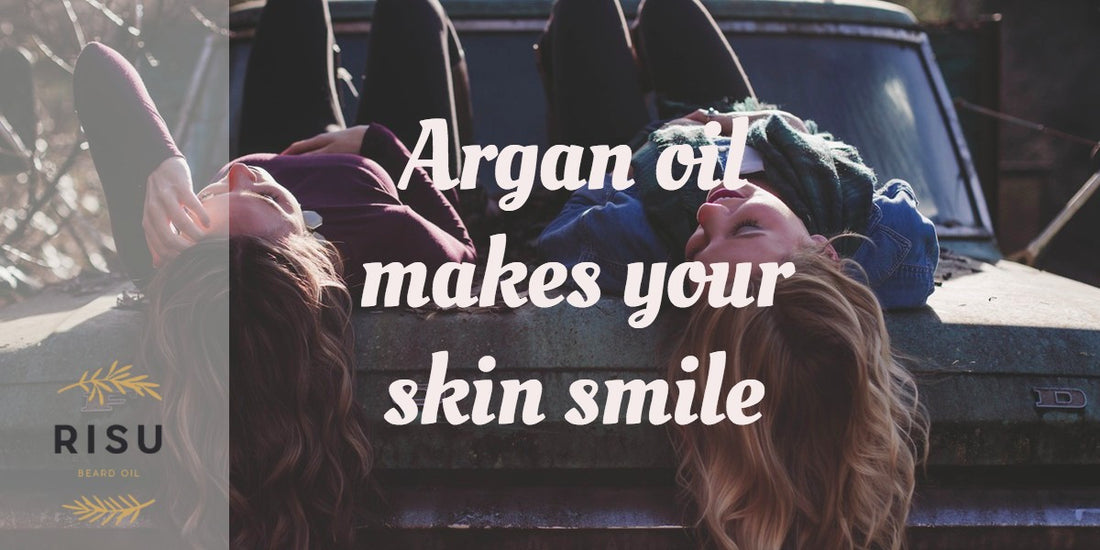
How and why does the beard oil work? Part 2.
In this series we will cover the benefits of different ingredients of each used oil. Risu is formatted with quality and effect in mind. We want to include you why we use and trust each ingredient that can be found inside Risu Beard Oil bottle.
One of our bearded customers told us that his girlfriend is using the beard oil for her skin. Apparently it works as skin moisturizer for the girls too (how could it be possible?). Main ingredient in our beard oil is Argan oil, which in it self is really good for your skin. More than half In every Risu Beard Oil bottle is consisted of Argan oil. We use 100 % organic Argan spinosa kernel oil straight from Morocco.
Argan oil is prepared from the fruits of argan trees (Argania spinosa (L.) Skeels) following a multistep process. When the kernels contained in the argan fruits are slightly roasted prior to grinding, edible argan oil is obtained. Unroasted kernels are saved to prepare an oil used in cosmetology. Until the 1980’s, argan oil was considered as a tourist attraction sold in recycled plastic bottles along the dusty Moroccan roads. It is now frequently referred to as “the world’s most expensive vegetable oil”.
The argan tree

The argan tree of the family Sapotaceae is only endemic in Morocco, where argan groves naturally cover about 8000 km2. The argan tree is a slow-growing spiny tree and is either shrubby or up to 10 m high when isolated and growing in a favourable environment. The argan tree life span frequently exceeds 200 years. The argan tree actively protects the superficial earth crust against heavy rain or wind induced erosion.
Because its root network reaches deeply into the soil, the argan tree presents the ability to resist severe drought, and it is often the ultimate warrior when the desert is encroaching on the land. The argan tree’s large canopy also shades domestic cultures and maintains the soil fertility.
For years, argan forest dwellers have claimed that argan oil is hepatoprotective and choleretic, that it prevents diabetes and that it has anti-inflammatory properties. As a cosmetic, argan oil revitalises the skin, helps with acne, hydrates dry skin, makes hair and beard shine. We made different mixes in our beard oil, and the best results we got from using Argan oil as our main ingredient.
The argan oil is constitute of acylglycerols, including 95% of triacylglycerols, constitute 99% of extract. The remaining 4% are com- posed of monoacylglycerols (0.27% - 0.65%), diacyl- glycerols (0.68 - 1.53), and free fatty acids (1.1% - 2.0%)

Scientist says it works
The human hair is composed of protein, lipid, water, melanin and trace elements. The main constituents of hair are of α-keratin, a group of proteins, which account for 65% - 95% of hair weight. It is responsible for conferring mechanical properties such as elasticity, shape, strength and functionality. A study was conducted to discover how well argan oil prevents protein loss from Caucasian human hair post treatment of strong hair dye. The result was noticeable even after the first apply. This is why you can feel the difference on your beard immediately, if you have never tried beard oil before.
As we have stated before, the healthy skin and the root of the hair produces stonger beard. That’s why we have to concentrate also on the benefits it has on the skin beneath the beard.
Another study concentrated strictly to discover the benefits for the skin. The anti-sebum activity of topical argan oil was demonstrated on 20 17- to 50-year-old volunteers with oily facial skin. Sebum level was determined on forehead and both cheeks. A twice daily facial application of an argan oil-containing cream for four weeks revealed significant anti-sebum activity that translated to reduced greasiness and improved appearance of oily facial skin. So if you suffer oily skin, you can apply the beard oil in your cheeks and forehead and test for yourself.
Further read and sauces.
http://www.sidiyassine.com/documents/science/review_argan_oil_euro_lipides_j_2008.pdf
http://file.scirp.org/Html/36776.html
Also here is a relevant photo of a goat eating the Argan fruits. Somehow.
